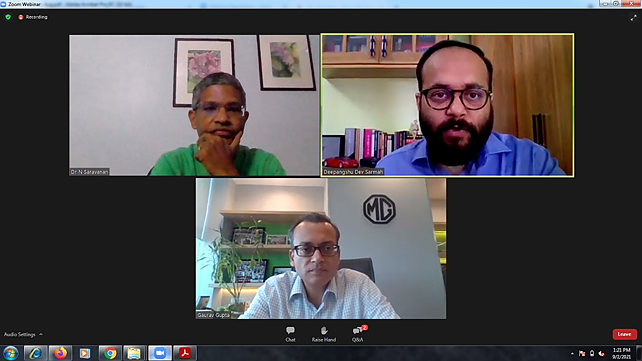
The future mobility presents tremendous opportunities for automotive electronics in India as this segment is expected to reach $ 30 billion by 2025, Guruprasad Mudlapur, CTO, Bosch Limited & MD, Bosch Automotive Electronics India, has said.
Delivering his inaugural address at the webinar on Automotive Electronics with the theme – The Efficiency Augmenter (focus on performance, comfort & convenience), organised by Mobility Outlook, Mudlapur said the number of electronic features in an entry-level car is about 12 representing up to 10% of the vehicle cost. In the mid and executive segment, the number of features jumps to about 45, taking a share of about 15% of the cost of the vehicle. However, the cost of electronic features is estimated at around 25% of the premium car having more than 60 electronic features, he said.
The complexity increases in direct proportion to the number of electronics features in vehicles; this adds to the cost of the vehicle. In electric vehicles, the electronics features multiply, while the cost is mainly driven by batteries.
In conventional 2Ws, electronics features will increase from about ten at present up to 30 by 2025 and up to 50 in e2Ws. Therefore, there are immense opportunities for the players in this space in several areas, including powertrain, brake & chassis, infotainment, connectivity, HMI, telematics, body electronics, ADAS and safety, he said.
The future of electrical/electronic architecture will move from the present distributed system to domain centralised and finally to vehicle centralised architecture in the future, he said. However, he added that there are several issues for India in terms of localisation, vehicle complexity, FTAs/ regional cooperation, design-led growth, and lack of engineering talent.
Binoy Paul, Chief Engineer - E/E, Mahindra & Mahindra, said electronics define modern vehicles. With the possibilities of showcasing product differentiation through software, electronics cannot be ignored anymore. The industry in India is more than ready to embrace electronics as capabilities coupled with talent are available for global organisations. “I see a bright future for automotive electronics,” in India, though there are challenges such as availability of semiconductors and lack of ecosystem, he said.
Giving the consultant perspective, Kaushik Madhavan, Vice President (Mobility), Frost & Sullivan, said that the Asia Pacific is the key growth driver for the automotive electronics market. Electrification, ADAS, and infotainment electronics offer significant opportunities towards 2030 for Indian suppliers.
Regulations and customer pull are the key drivers for the increase in electronic content in cars, as about 90% of innovations in modern cars are based on new developments in electronics.
However, Madhavan said that a new vision for producing and consuming electronic and electrical goods is required to establish a circular value chain. He reiterated that guidance and support from the government, shared responsibility, and investments will be the crucial framework for developing the ecosystem in India.
End-to-end system development, multiple domain expertise and low engineering costs are the major areas to be focused on by the India suppliers in embedded engineering services, he added.
As part of the webinar, there were technology presentations by Anoop Aggarwal, Senior Manager – Automotive (Vehicle User Experience), Infineon Technologies India and Rashmi Rao, Industry Manager Automotive, MathWorks.
The panel discussion on ‘Automotive Electronics - Chasing Opportunities Amidst A Global Crisis’ was participated by Dr Anshuman Awasthi, VP - eDrive, Hybrids, and Powertrain EE, Mercedes-Benz Research and Development India, Ramanathan V, VP & Head - OE Sales and Marketing, WABCO India, Sapna Ahuja, COO, MapmyIndia, PK Banerjee, ED, SIAM, Srinivas Aravapalli, CEO, Bluebinaries Engineering and Solutions and Dr Madhusudan Joshi, DGM, ICAT. It was moderated by Ashim Sharma, Partner & Group Head (Auto, Engg. & Logistics), Nomura Research Institute.

Delivering the valedictory address, Dr N Saravanan, President & CTO, Ashok Leyland, said the future is electronics as they can convert the mechanical systems to benefit the end-users in terms of enhancing the total cost of ownership, which is a key determinant for the commercial vehicle customers.
The key reason for the delay in most product launches during the past five years is the delayed software application in the development process, he pointed out. Therefore, the essential requirements to execute electronics include connectivity and software responsible for advanced product features that differentiate customer experience and productivity.
Additionally, scalable, cost-effective hardware and software platforms enabling continuous release over the product’s lifecycle is critical, he said.
He further said that the need for autonomous, electrification, connectivity significantly increases the need for electronics.
Dr Saravanan concluded that it is necessary to move towards an ecosystem approach from the product approach, and there is a need to look at hardware and software as a tightly knit technology stack to achieve the ecosystem benefits.
Gaurav Gupta, Chief Commercial Officer, MG Motor India, said the mobility solutions for the future would be developed by the confluence of OEMs, software developers and engineers, where electronics will play a critical role. This is because the end-users transfer their living room to the vehicle. It is an experience rather than ownership for the next-gen buyers; experience is continuity, which is why many startups get into the tech auto space. Ultimately the electronics ecosystem will drive the future, Gupta added.